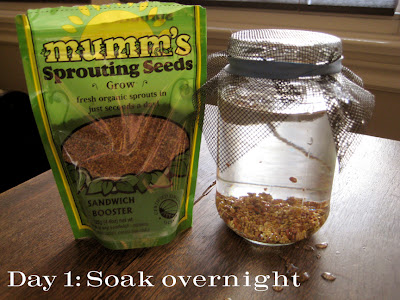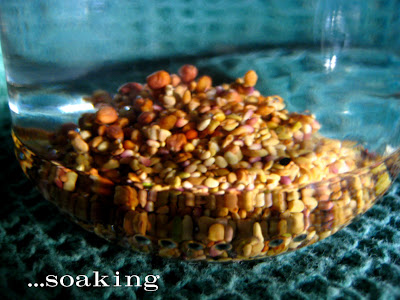Since we’re now in the dead of winter and we’re not exactly getting much in the way of local produce anymore, I thought it would be a great time to introduce ya’ll to the wonderful world of sprouts! I’m sure that most of you have eaten sprouts before and seen them in those little plastic boxes at the grocery store, but I am going to show you that growing your own is so fast, easy and inexpensive that you can have your very own organic garden on your kitchen counter for the rest of your life.
Why should I sprout?
Sprouts are the most vitally alive and nourishing foods we can eat. Once sprouted, grains, seeds and beans have 15% – 30% more protein, up to 10 times the B-vitamins, more vitamin C, vitamin E and K, beta-carotene, calcium, phosphorus and iron. They absolutely qualify as “super foods”. For those trying to lose weight, sprouts provide a low-calorie, high-nutrient food that tends to support improved metabolism.
Sprouting at home takes only a few seconds a day and can produce a good part of your daily requirements of the nutrients you need from fresh produce. The hassles are minor, the costs are low, and the health benefits are immeasurable.
What can I sprout?
Chickpea, alfalfa, sunflower, lentil, wheat, quinoa, mung bean, adzuki bean, clover and radish are just a few of the protein and vitamin-rich sprouts of many possible seeds, grains and beans. Really, any “seed” that is endowed with the potential for the next generation of plant life is sproutable.
What do I need to sprout?
1. A jar, 1 liter to 4 liter (1qt. to gallon) size, depending on your appetite for sprouts and size of your family.
2. A bowl of the right size and weight to prop up the jar.
3. Some screen or netting and a rubber band. You can use an old pair of nylons, cheesecloth, or screen from a hardware store.
4. Fresh water.
5. Seeds with good germination, preferably grown organically. Avoid purchased garden seeds unless you know they aren’t treated. Most natural food stores have the common sprouting seeds; if in doubt, ask if it’s organic. You can also grab some right out of the bulk bin at a health food store – chickpeas are my favorite. Most seeds keep for a year or more in a cool dry place.
How to Sprout:
Easy Sprouting Directions (for most small seeds)
1. Soak: Put 1 to 4 TBS. seed in a wide mouth jar. Cover with mesh and secure with rubber band. Add water, swirl, and drain. Add 1 cup cool water and soak for 4 – 8 hours (or overnight).
2. Rinse: twice a day, refill jar with cool water, swirl, and drain. Invert jar and prop at angle in sink or bowl.
3. Enjoy in three to six days, when sprouts are 3 to 5cm (1 to 2″) long. Cover the jar with plastic and a rubber band, or transfer to a covered container, and refrigerate to store. It’s really that easy!
Below are some photos of my own alfalfa sprouts. I like to put them on sandwiches or salads for added crunch, flavour and of course, nutrition.
Remember, if you ever have any questions, please feel free to ask me in the comments section. I am your resource for all things holistic!
All the best and Happy sprouting, Sarah B









hi just came across this site. even though this was an old post really great info
Hi Sarah,
I’m a fellow Canadian, lover of healthy food and huge fan of your blog & cookbook. I read an article picturing your “favourite kitchen tool”, a terracotta sprouter. Could you please email me or post more info, like the brand name, where you purchased, how many tiers it is? I searched online and the ones I found looked a bit different from yours. Please advise. Thanks for your time!
Kind regards,
Andrea
I’ve tried twice now and both times the sprouts were bitter. What did I do wrong ??
Hi Jeff – sorry to hear that, but some sprouts are naturally very bitter! Try some lentils – they tend to be on the sweeter side of the sprout family 🙂 Good luck!
Sarah B
hey I recently tried sprouting and I thought I was suppose to soak them in water continually so I soaked them,for,3 days, still draining and rinsing but then kept soaking until I started to question why nothing was hapepening. now I’m just rinsing and draining but have I failed my first attempt and need to start with new seeds??? please email me back thank you
Dear Sara,
I would love to try this! But I am pregnant and I don’t know if I should have any kind of special precocious during the process to avoid contamination?
Thank you so much!
With love,
Sofia
do you have a recipe for sprouted bread like the ezikiel bread. love that but very expensive
Does anyone have a good recipe to use sprouted grains for a bread recipe? I have a friend that tried one recipe with sprouted grains, but it didn’t rise properly. She would like to find other recipes to make bread. Thank you for anyones response.
can I use chia seeds?
I had heard (from my ecology teacher) that sprouts contain increased amounts of carcinogens; an adaptive strategy that young plants employ to discourage grazing. What is your knowledge/thinking regarding this?
thanks!
Can you show a picture of what to do with the bowl? Is it just during draining or do I have to keep it there for a while?
What if I grew fields of quinoa? Could I use it as cattle feed, and produce uniquely nutritious beef?
can i do pinto beans
Hi Rich – yes any beans will work! Just make sure they are organic because non-organic legumes have often been irradiated and will not sprout.
Where can I buy the seeds at?
Hi Kelly – any health food shop will have them, or just buy lentils and beans at your grocery store! Online is also an option.
May I ask if I need to put the jar under the sun or I should put the jar away from sunlight?
Hi Adela – definitely keep the jar away from the sun. I cover mine with a tea towel to prevent light from getting in. Happy sprouting!
where can I order them?
Love bean sprouts, thanks for sharing!
Great post! I love that it is so easy. 🙂
I can’t find the video you described?
where would I get alfalfa seed?
You can order them online, but any health food store will sell the seeds 🙂
I’m on Coumadine so I must watch the amount of Vitamin K (mcg’s) that I consume daily, Where can I get a sprout list with Vitamin K content information ?
Love the idea of growing your own sprouts! Why not! Love your blog…fits right in with my NY’s resolution! Get healthy!! Thanks!
I have a friend that probably knows how to sprout grains, but has been looking for a homemade bread recipe to use with sprouted grains. Does anyone have a recipe they could share that uses sprouted grains? Please reply if you have a recipe. Thank you
If you sprout wheat seeds and then dry them in a dehydrator, they can be milled into sprouted wheat flour and used as part of your recipe (maybe a tablespoon per loaf). Additionally, you could throw in some other whole sprouts in your dough for increased aesthetics and nutrition.
Before having to go gluten-free I’d made sprouted grain bread. I used all the grains from the Ezekiel bread. Same process; soak, rinse and repeat for three days. Then put the drained sprouting grains through a food mill to grind them. This will be wet and a bit like hamburger. Use the same measurements you’d use for a loaf of bread (eg. 3 cups) and mix with sugar/honey & yeast. Let rise and bake.
I sprouted many years ago when my kids were young. It was perfect. However, now I’m always reading that they can be contaminated somehow and we shouldn’t buy in store, or do ourself. Should I worry? or just go ahead?
Hi Denise – get back on the sprouting train! The only reason that sprouts in the stores are contaminated is because they often sit in water too long or the quality of the water used to grow them is poor. If you grow them yourself you should be fine. If you are really worried about mould, rinse the sprouts daily in vitamin C powder. Hope that helps!
If you sprout, say chickpeas, can you eat the actual chickpea? Just wondering if you can eat the larger things, or if they’d be to hard to chew.
Was wondering if you actually can eat the seeds along with the sprouts with the things you sprout, ie. the sprout grows from the chickpea do you eat the sprout and chickpea or just the sprout that is grown
Hi Ethel – eat the whole thing! It’s delicious!
hi. im interested in sprouting but have never done it before. in one of your posts you mentioned you bought the gaia sprouter and im considering buying one also. do you recommend it for a beginner or would you suggest i buy a simpler model? anxiously waiting for your reply!
tina
Hi Sarah,
Thanks for this post. I’d love to try sprouting my own seeds. I live in Holland and haven’t had much success locating sprouting seeds. Can you recommend a website to buy some from?
Thanks,
Michelle
How funny are that New Zealand couple? Hilarious 🙂 Great video to post for this subject and great post & blog too.
Thanks Sarah! I just picked up some seeds and am going to experiment this week. SO excited 🙂 thanks for all of your lovely recipes and tips!
bETHANY
Hi Bethany!
Good questions. You can eat all sprouts raw – in fact they should be eaten raw so you can take advantage of their potency, which would diminish with cooking. And you can sprout anything that is a viable seed: chickpeas, lentils, quinoa, radish, broccoli, arugula, sunflower…the list goes on! As for recipes, just throw them on anything. Sandwiches, soup, salads, or top a stir-fry with some crunchy goodness. Happy sprouting!
In health, Sarah B.
Hi! I am of course familiar with eating alfalfa sprouts, can you eat all others raw in the same fashion? do you cook the others? have any handy sprouts recipes? thanks!!
Great Blogspot Sarah! Good info for the peeps! How the heck are you?
Meghan Harris
Hey Sarah,
Thanks for introducing me to your excellent web site! I have just read your sprouts blog and it is perfect for me! I thought I should let you know that I am very turned on by the prospect of living healthier! Keep up the great work…I look forward to reading the rest of your blogs and will keep intouch with new submissions.
Thanks!
Hey Claire,
you absolutely can use the extra grains, beans or seeds that you have on hand. It is actually a great way to use up the ends of the bag! Have fun.
ack! COOL!
So, I can do this with the lentils /quinoa / etc I have on hand??